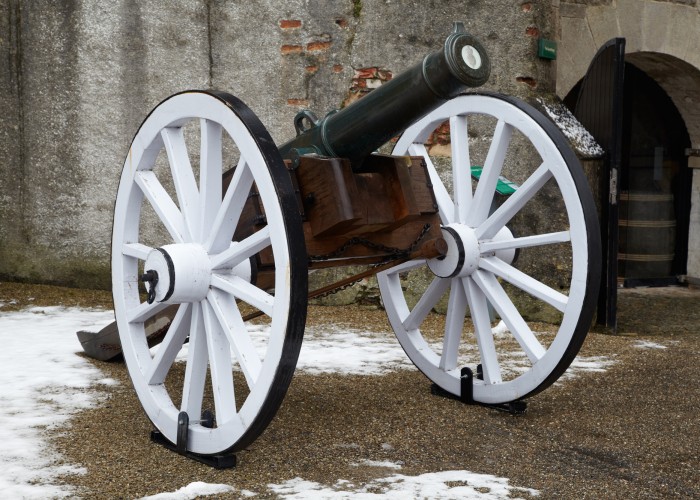British Cannon used at Waterloo
This is a British “Blomfield” cannon used at the Battle of Waterloo. The heaviest type of artillery used by the British Army at Waterloo, it fired a solid cannonball weighing nine pounds (about four kilos). Cannons were a vital part of warfare at the time of Waterloo, with the ability to rip through massed ranks of troops and inflict terrible casualties.
In 1780 Captain Thomas Blomfield RA was appointed Inspector of Artillery and Superintendent of the Royal Brass Foundry. Three years later he was given responsibility for re-organising the Ordnance Department. At the same time he was experimenting with new forms of ordnance. The resultant Blomfield guns had thicker breeches, thinner chases and a cascabel ring to control recoil, making them stronger without increasing their weight.
The Blomfield 9-pounder cannon was introduced to the Royal Artillery (RA) in 1805 as a response to the heavier French calibre guns. At Waterloo Wellington had 157 pieces but only 60 were 9-pdrs, in 12 batteries. The remaining 13 batteries had 6-pdrs and howitzers. Interestingly, the Dutch-Belgian and Brunswick Artillery, who fought alongside the British at Waterloo, used French cannons (known as An. XI Ordnance). Wellington employed his Royal Horse Artillery very effectively during the battle as a mobile reserve to plug holes in his line. For example, with Hougoumont under attack, Major Bull’s troop was brought forward in support from its original position towards the rear of the allied position.
The allied artillery faced 246 pieces in 34 French batteries. As was his usual tactic, Napoleon started the battle with a heavy artillery bombardment on the Allied line to soften up the enemy.
Cannons on both sides used round-shot that was lethal against columns of infantry, knocking down several men at once for as long as the ball continued to travel. Case shot or canister (tin coated iron cans) packed with smaller iron balls was devastating at close range. Only the British used spherical case (Shrapnel) where a shell was filled with small iron balls. A specially cut wooden fuse detonated a bursting charge.
The technology to produce cannon was an integral part of the Industrial Revolution. Other technological developments were the introduction of water-powered machines, the tin can, improved metal alloys, accurately bored cylinders for steam engines, and even ordnance survey maps.
-
Education overview
Discover the life of an artillery soldier in the Waterloo 200 Schools E-Book. Elizabeth College have researched Captain George McLeod Baynes and created a tribute to his service. To find out how to sign up your class and discover your local Waterloo history, contact [email protected].
-
Curatorial info
- Originating Museum: Inniskillings Museum
- Production Date: 1813
-
Use this image
You can download and use the high resolution image for use in a non-profit environment such as a school or college, but please take note of the license type and rights holder information below
- Rights Holder: Inniskillings Regimental Museum. Photography Relic Imaging Ltd.
- License Type: Creative Commons
Find it here
This object is in the collection of Royal Inniskilling Fusiliers Regimental Museum











